If you haven’t already done so, please read the FFY Introduction.
August Farm Tasks Overview
Here’s a breakdown of what we’re covering in May:
- Burnout
- Revisit Fall Plan
- Ordering
- Planting/Sowing
- Dahlias
- High Tunnel
- Harvesting
- Business & Taxes: Keeping up with bookkeeping

Burnout
Have you experienced burnout this season? Perhaps you’re in it right now. Maybe you’re not reading this, saving it for a slower time of year, because you are in the thick of it.
Burnout is normal. It does not mean that we are bad farmers or doing anything wrong.
I think the only thing wrong with burnout is that we don’t talk about it enough. I’ve had growing friends throw in the towel because it just got to be too much. This is OK, of course, but I also hope when we are all faced with a period of burnout, we can remember that it doesn’t have to be all or nothing. In my experience, it’s cyclical, and if we can allow ourselves the grace to ride that wave, we only get stronger each time we float back around.
I haven’t had a year without it, my most-recent one was early August. We had a few weddings and events in July, the most I’ve ever done. And while these have quickly become one of my favorite ways to share flowers, they tend to take up a large amount of time and energy. Other tasks fell behind, and I felt overwhelmed and burnt out.
I thought I’d share some things that help me get through periods of burnout, but the number one thing is always doing whatever the hell feels right for you. Sometimes, trying to codify burnout just leads to more overwhelm, so definitely do what feels best. I like to keep a note in my phone of things that work so when I cannot brain any more, I have little reminders.

1. Do. Nothing. Or Something That Feels Like Nothing.
At peak burnout, I try to find time for . . . nothing. Just allowing myself the grace to do absolutely nothing or whatever feels relaxing: Extra Netflix, reading a book, sleeping in, taking longer mornings on the deck drinking coffee, even staying up a little later with an extra glass of bourbon. Without feeling guilty (or my version of not feeling guilty, which looks more like not giving a F).
Meditation. It might sound cliche, but I’ve meditated for years and I always stop during busy periods. However, I once heard someone say that if you cannot find 10 minutes to meditate, you need it then more than ever. Getting back into this practice grounds and restores me, even if it’s just 10 minutes per day.
2. Do What You Must, Then Fit In The Rest When You Can
It’s easy to say, “take a break when you’re feeling burnt out” but there are still things that need to get done, especially on a farm. The plants need water, the animals need food, things need tending. I’m sure like me, you likely have a job, a family, and/or other responsibilities.
I try to cross those “Must Dos” off of the list or enlist help if I can. Then, for the things that are a little more flexible, I try and allow myself to do them when I feel like it. Don’t feel like working outside in the blistering heat, try answering emails. Don’t want to look at a computer or post on social media? Try something mindless like weeding. Have the weeds gotten totally away from you? Mow that bed down and forget about it or keep things at bay with a weed whacker.
Honestly, a weed whacker could be its own number. If weeds are getting away from me, I can at least whack them down so they don’t go to seed, so I can deal with them later. Matt’s parents’ farm is really close to ours and they have a Dewalt battery-operated weed whacker, so that’s what I’ve been using. I love it so much though, I may just get another one.
3. Doing Things That Recharge and Inspire
Going out to dinner, spending time with family/friends, going out of town (gasp). These all can sound crazy when you feel behind. They mean more things won’t get done, yup. But for me, these types of things recharge my batteries and reset my mental state, allowing more space later on.
Researching things I enjoy outside of farming (e.g. health and wellness, I love diving deep on different subjects).
Taking the time to cook a from-scratch meal. Making dinner every night can feel super overwhelming (if that’s the case, order out, whatever works), but I love cooking a from-scratch meal if I actually give myself adequate time . . . especially with homegrown food from the garden. It feels restorative. The first week in August, I finally had no events. The thought of doing any type of work sounded impossible (even work I normally love). So, I just stayed in and made homemade egg noodles and sauce with all the herbs/veg from the garden for manicotti. And we had a *really* nice bottle of wine with it for dinner. Bonus, I made a ton, so we had some homemade freezer meals for when I felt like working again.
And this is key for me in periods of burnout: when I feel like doing something that can also serve me later (making a meal ahead, learning something new), I don’t feel as much anxiety about the chores going on the back burner.
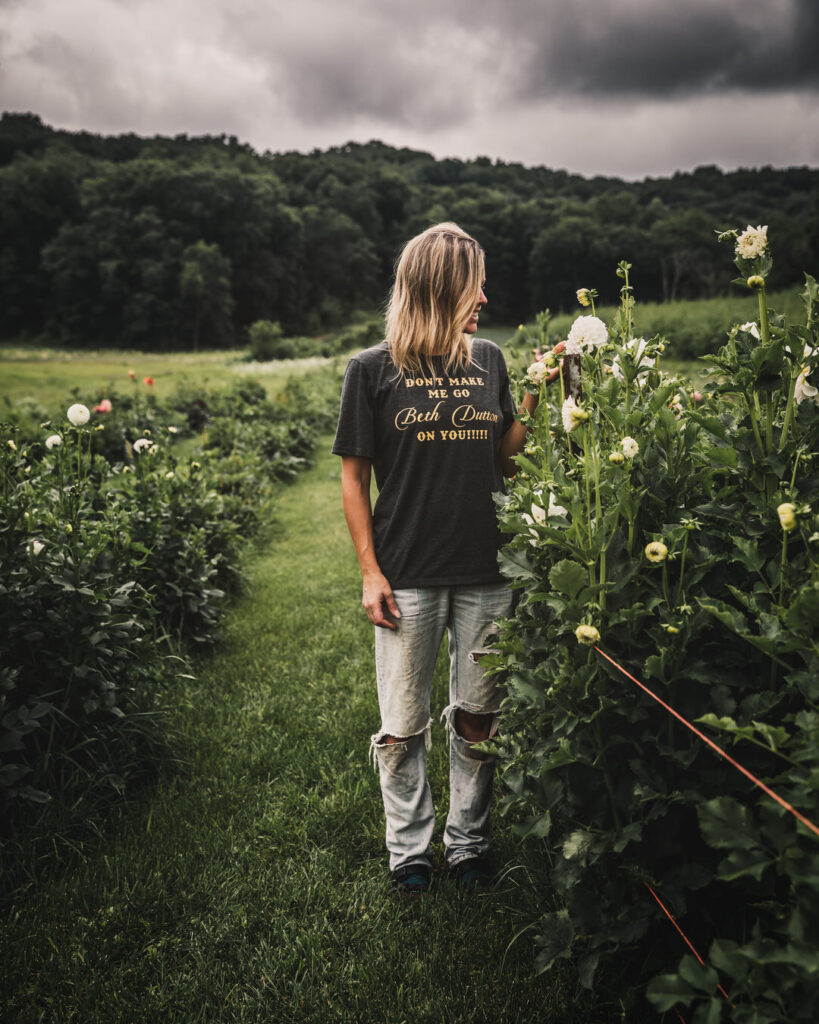


4. Movement
Farming is a physical job. During the season, I don’t usually have room for other types of exercise. When you’re feeling burnt out, getting exercise in other ways might sound like the last thing you want to do, but it has so many incredible benefits. I try and make it playful.
For example, we’ve been riding our bikes most evenings over to the Airbnb to walk through the dahlias. It’s about a 25-30 minute roundtrip easy ride; think more like riding your bike when you were a kid, less like a cycling/spin class. Having the dahlias as a destination makes it motivating and there are no distractions.
We’ve also started doing some yoga again. I’ve always loved yoga (I was a competitive gymnast in my younger years, so I find the movements similar). Matt does it with me occasionally, because he’s seen a benefit with his back issues. Boho Beautiful, kind of a cringey name, but they have incredible yoga videos on YouTube for whatever mood you are in, and they are FREE. It feels so good to move my body in a different way.
5. Out of Office + Prioritizing Communication
One of the most challenging things for me during the season even when I am NOT burnt out is keeping up with emails, DMs, and other communication. Sometimes, the messages pile up. I always respond to each one, and it’s important to me that my responses are thoughtful. The downfall of this is that it takes time. If I tried to get to them all, I wouldn’t have time for anything else.
Sometimes I think: How can email be *this* hard? But if you’re like me, you may have another job. For mine, I easily receive 100+ emails/messages a day. Add on farming communication, and oy, a person can only handle so much computer time. If you’re in a similar situation, it’s important to eventually walk away from the computer.
Putting an Out of Office doesn’t alleviate the need to answer messages, but it does let your customer know that your response times are delayed. During busy times, we have a limited amount of time for email, but we try and assure people that we will get back to them when we are able to.
For my repeat customers, florists, and brides/event clients (only those with *scheduled* dates, meaning their deposit is paid, and usually closer to their event date), I give my phone number if they need anything responded to immediately.
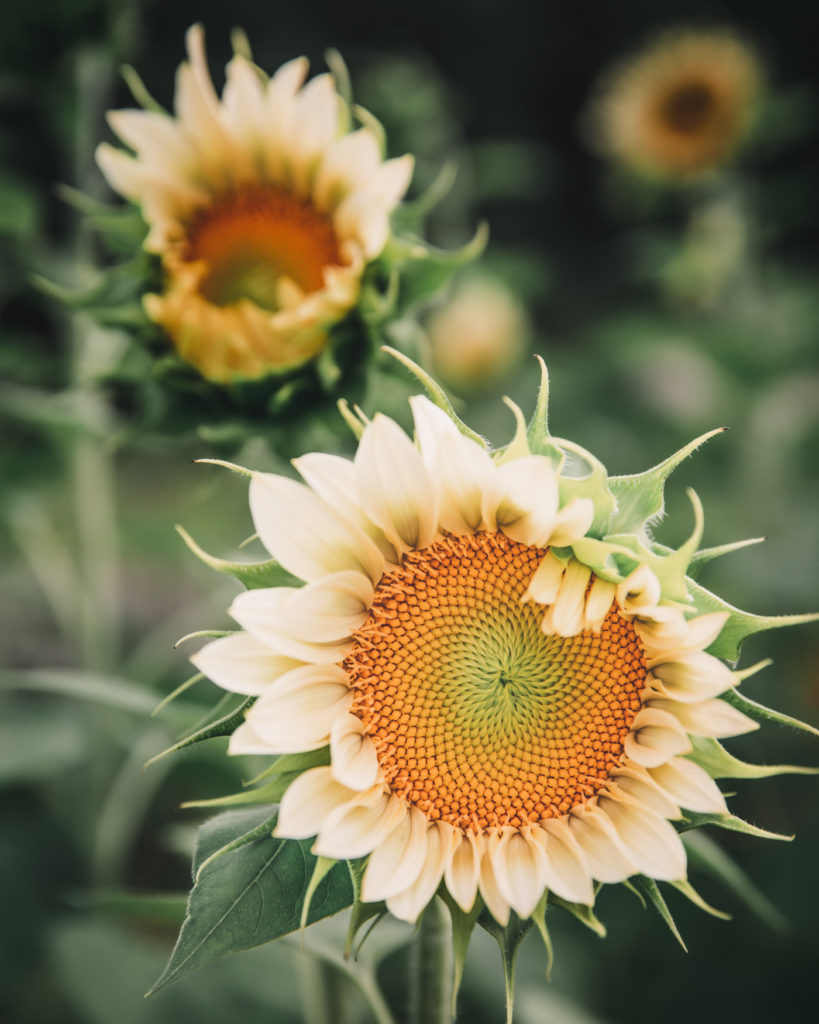
6. Remembering That Feeling Bad Can Be Good, But Also Not To Take Myself Too Seriously
No, really. Research suggests that people who embrace their failure and the negative feelings that come with it are more likely to succeed in the future. I have to remind myself that when I feel bad or burnt out, I don’t need to feel bad about feeling bad (like, I legit feel guilty about feeling bad, so I’ll be all: EVERYTHING IS FINE)! It’s better to embrace the negative feelings and learn from them, if that makes sense.
The key for me is remembering that these feelings are not who I am, they are just what I am currently experiencing. I try to remind myself that losing the battle to weeds or letting emails go unanswered for another few days does feel crappy, yes, but that I, personally, am not crappy (I’m just having a crappy moment and hopefully I can learn to have less of them 🙂 ).
Have I lost out on business? Absolutely, and the feeling of lost opportunity leaves a giant pit in my stomach. And that’s OK! It’s OK because I can learn from it.
But also: It’s not the end of the world.
Luckily, I have a partner who reminds me to laugh at myself and adds levity to situations just when I need it most. Surround yourself with people like that, or even better: be that person for yourself and those around you. Feel the feelings but also laugh at the absurdity that we are living on a planet that is just swirling around in circles in a vast universe and we’re all just trying to figure it out.
7. Take Notes
So, feel the feelz, but remember that part about taking responsibility and improving? I take notes to remind myself of what worked and did not work for me both during this period, but also what got me here in the first place. I know that weddings and events left me a little overwhelmed, but the truth is that I absolutely love doing them. What that means for me is that I need a better plan for weeds, email communication, and other chores that got behind (when I drill down, this is what actually stressed me out).
Also, as our business has grown and evolved, so has what we’re able to manage. I think this is true for most businesses. When you grow in one area, it either means cutting back in another or ramping up staffing or technology to accommodate that growth.
We’ve doubled the amount of dahlias we’ve grown year after year, which has required more labor/time from us. While Matt has taken on much more responsibility with the dahlias (hence, they are the best looking crops on our farm right now, ha), they do take precedence and I am noting that this may affect what we’re able to take on. I’ve already let my florists know that availability will be limited for lisianthus, sunflowers, and dahlias for the remainder of the season (and I have notes reminding me of this for next season).
OK, these were the major of things that have helped me during times of burnout. Do you have any tips for what has worked well for you? I’d love to hear them!
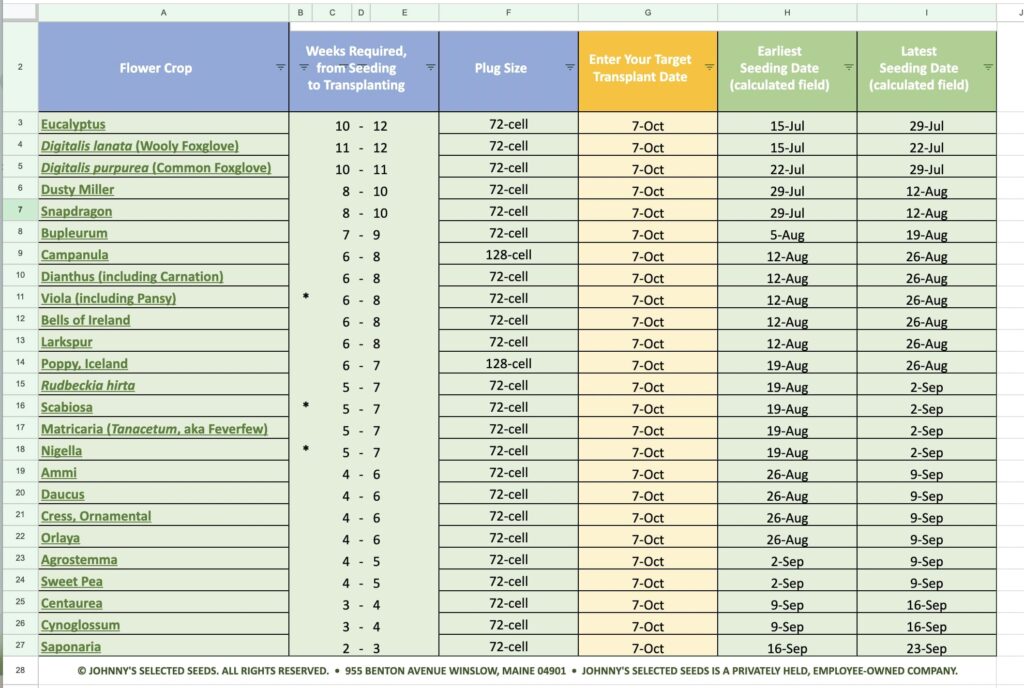
Revisit Fall Plan
If you haven’t yet, there is still time to revisit your fall plan (or make one). While I use my own Seed Sowing & Planning Spreadsheet for spring and summer (which is shared in January), for fall planning, I’m currently using Johnny’s Seeding Date Calculator. It’s based on their multi-year overwintering trials and you can find it for free here. I didn’t feel the need to reinvent the wheel on this one, so I simply keep it all together with my own spreadsheet on a separate tab.
In order to use the calculator, you need to know your last 10-hour day of the year. You can use a calculator like this one to determine this.
If you’re serious about experimenting with overwintering, especially if you’re in a colder zone, I highly suggest checking out Johnny’s Overwinter Flowers Resources page, where you will find the complete listing of their crop and method videos, plus spreadsheets and PDFs detailing more than 25 cut-flower crops they have successfully overwintered in their Zone 5a unheated tunnel. Their results include yield, rate of survival, and specific variety recommendations!
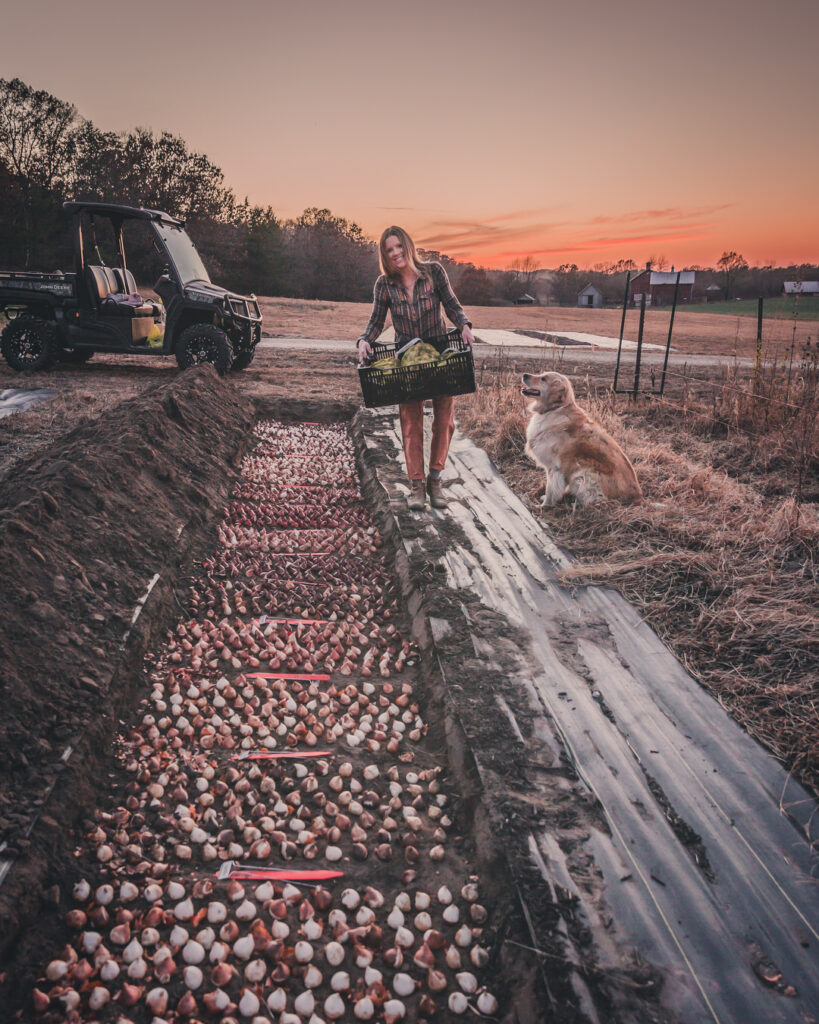
Ordering
Here in the northern hemisphere, now is the perfect time to order seeds for your fall planting (and even start taking inventory and ordering for next season).
This is hard to believe, but dahlia tuber sales will also be starting soon (and continue through spring 2024). Check out Dahlia Addict for upcoming sales.
If you don’t order bulbs, corms, or bareroot peonies wholesale, there will be many retail sales coming up (including ours . . . I sent you a coupon code in your email for 20% off, the deepest discount we don’t offer anyone else . . . a small THANK YOU for being on this journey with me). A few others I know of are The Farmhouse Flower Farm and The Flower Hat. If you are able to order wholesale (you have a resale certificate) but want smaller quantities, check out Little Farmhouse Flowers. Side note: If you have not started a business but plan to, I beg you not to put Farmhouse in it. I love it namewise, but I can never keep them straight (every time I recommend Marryn or Linda, I have to look up who is who). It’s not a bad thing, they have amazingly successful businesses, but the names are hard to keep straight for simple folk, like meeee.
Now is also the perfect time to start thinking about ordering for . . . Christmas! Oy, I know, I can’t even. Thus far, we personally take the winter off (but I have been practicing my wreath making😉). We planted 800 Christmas trees this spring, so I do hope to someday have Christmas be a part of our business (because I want my life to be a Hallmark movie during the holidays). When I’ll pull the trigger on that has yet to be determined. However, if you are interested in ordering in wholesale greens, now is the time to do it. The Dirt on Flowers Podcast has a great episode on this. My pal Krynn @bloomchickflowercompany ‘s Christmas game is strong and she has a really awesome succinct post on sourcing. Check out both!

Planting/Sowing
We’re getting started on our sowing for our own overwinter trials, including digitalis, delphinium, and snapdragons.
Dahlias
If you’ve been around, you know that I find dahlias to be a year-round plant. Right now, they are taking center stage and the majority of our efforts for the remainder of the season will be geared toward them.
We harvest dahlias about every three days. This means that the blooms are always at the right stage and aren’t left to go to seed. Similarly, this ensures a steady supply of blooms because the plants are not putting energy into producing seeds.
Interestingly, Kristine Albrecht has explained that this is also super important for tuber production. Plants prioritize flowers and seeds with only excess nutrients going into tuber production. She states, “Suppose a dahlia plant is not deadheaded, and its flowers go to seed. In that case, the seeds will consume the lion’s share of the nutrients, leaving little excess for tuber production.” For this reason, disbudding, cutting blooms regularly, and deadheading old blooms is important for robust tuber production.
Because tuber production is an important part of our business, both for our own production as well as our dahlia tuber sale, we not only keep them deadheaded, but we’re also focused on monitoring plant health throughout the season, culling anything suspicious. We also do periodic testing for dahlia virus, but we usually keep this reserved for the end of the season (as disease can be passed on after a positive test). You can purchase at-home tests for some of the more-common varieties from Agdia. Similarly, we’re culling anything that is displaying a decline in genetics, such as open centers, or varieties that were mixups (especially if it was one we ordered and cannot identify).
We are double checking labels and cataloging everything: photos as well as keeping notes of plant traits and characteristics. With over 250 varieties, it’s a massive undertaking, but photographing and cataloging dahlias is one of my favorite parts of the job. It will be so helpful come winter when I can start organizing it all and writing descriptions.
While we haven’t gone through our second round of labeling, we will start doing that in the coming weeks. Each plant has a metal stake/label (I take a photo of this before photographing the actual flower). Before frost, I go through and label each plant with flagging tape. This helps ensure against label mixups. The flagging tape is also great for color coding, since Matt and I both work with the dahlias. If I label a variety green, that means it it was true to variety and I would consider selling it (based on positive characteristics, but depending on tuber production). Pink means to hold back from sale, whether I don’t feel there is enough or want to monitor the variety for longer. Orange is for any variety in a patch that was incorrect (whether a mistake on our end or one that was sent to us by mistake).

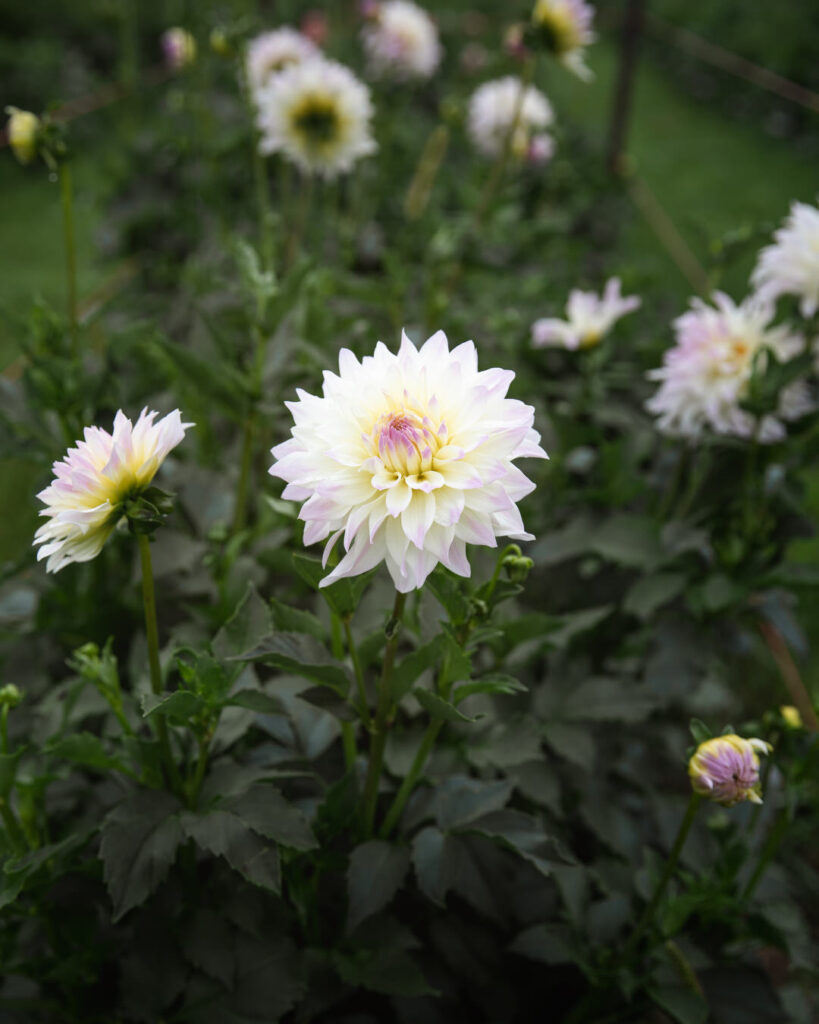
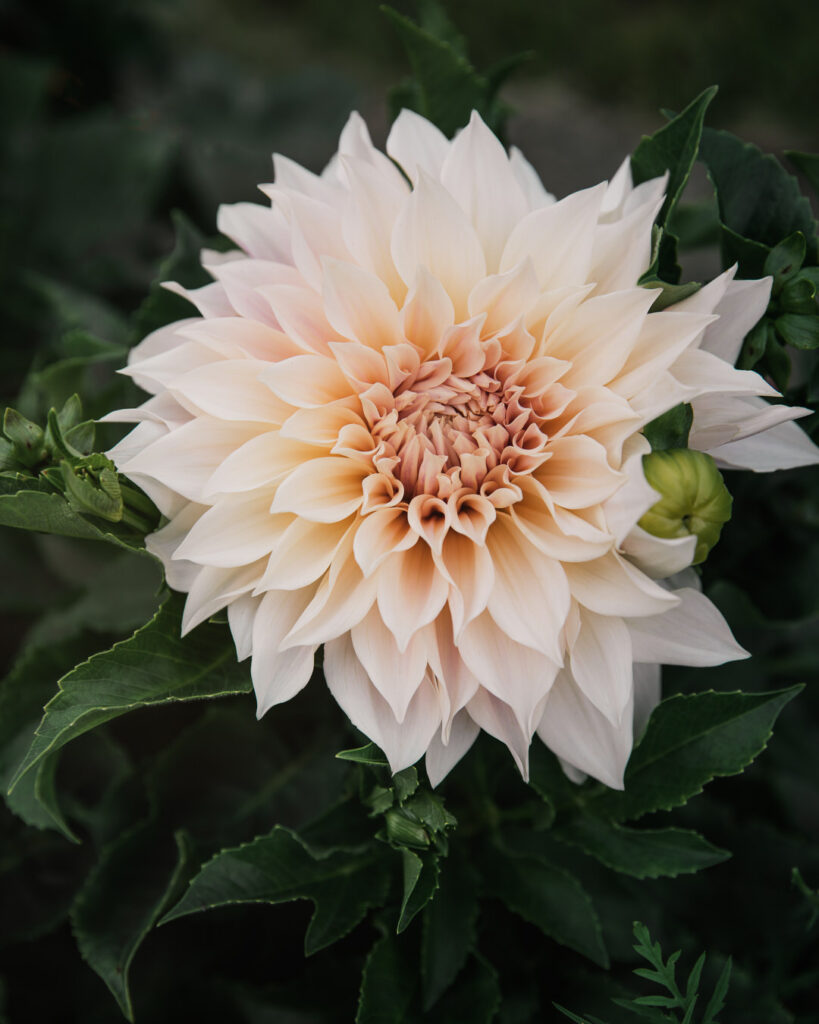

High Tunnel
The other major task and the one that I am kind of dreading is getting the high tunnel ready for overwintering/fall. It’s such prime growing space, but I am totally embarrassed to admit it has gotten out of control. We put so much into it to increase fertility, we even have tons of earth worms! I am literally shocked, we don’t have worms in the field (it’s so sad but true). We basically made a huge lasagna-style growing area for the tunnel, and it’s worked better than expected. When we moved the farm in 2019, soil organic matter was 0.06%. In the tunnel (in the same field), it’s not over 4%. If you’re curious how we did this:
Prior to building it we put in a cover crop (Johnny’s fall mix). Over fall, winter, spring we dumped chicken manure from the coop over it. In early spring, as soon as the ground was workable, we built the tunnel over this spot. We brought in loads of hay (we had rotted hay on hand from the horse barn at the Airbnb). Next, we sprinkled the entire hay area with Kenkashi Bokashi. It’s a microbe-rich compound which helps to accelerate decomposition through the introduction of fermenting bacteria. It contains endo and ecto mycorrhizal fungi spores to promote growth. Next, Matt randomly happened to find that an old pasture was being built upon and they needed to remove soil. We brought in loads of that and layered it on top with a lot of compost.
Year one was so-so, but this year it has completely taken off. In just one year, the difference in the plants is crazy. Along with that increased fertility, though, the weeds are also utterly insane (much more than I bargained for). I know I need a better method for keeping that beast under control. Growing in it is an absolute dream for me. I just want it to be one of those perfectly-manicured high tunnels, but it’s far from it. I was hoping not to till in the tunnel, but I think she needs a fresh restart for fall. We’ll cut back the crops/weeds with the weed whacker and till in.

Harvest
Things are certainly hitting peak, but our biggest focus for harvest are the dahlias, lisianthus, sunflowers (the successions that were not eaten by deer), zinnias, cosmos, amaranth, grasses, and whatever else I can manage. Also, I have cucumbers coming out of my ears, please send help!
Business & Taxes
I originally removed this so as not to be redundant each month, but I decided it’s important to keep it in:
Every month, I review our income and expenses and apply the Profit First method (at least, that’s my goal). If you haven’t read the book (Profit First: Transform Your Business from a Cash-Eating Monster to a Money-Making Machine (Entrepreneurship Simplified), I highly suggest it, but basically for everything that comes in (revenue) you are making target allocation percentages for things like profit, owner’s comp, taxes, and expenses.
Table example:
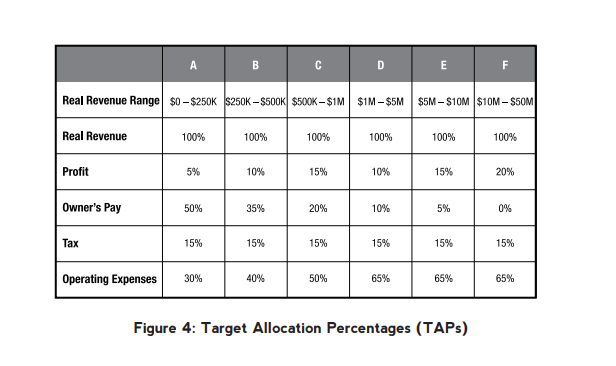
It’s actually recommended to do this twice a month, but I honestly consider it a win if I do it once. If those terms are foreign, that’s OK (they were for me too). He breaks it all down in a simple (and even entertaining) way. My only regret with this method is not starting it sooner. It’s given me more confidence as a business owner, especially as I do not come from an entrepreneurial family. If you’re not ready to dive on into the book, it’s important to understand your income and expenses. I don’t even use a fancy system like quickbooks, just a spreadsheet!
Wrap Up
OK, my friend, that is IT for August. What do you think? Did you find some useful nuggets? Is there anything that’s unclear or you wish I would have covered?
This link will be live until the end of next month, at which point you’ll get a PDF copy, so you can always refer back it. You can also use the buttons below to save this as a PDF or print at any time.
Tip: use the find shortcut (Ctrl+F on a PC or Command+F on a Mac to search for any word or term either online or in PDF format).
Have any questions or something you want to share with me or others? I know I say this ad nauseam, but I truly believe in the power of the collective and that we all have something unique and powerful to share, so please leave a question or share a comment below. We’re all better for it, and I thank you in advance!
Cheers pal!
What is the book recommendation? I clicked the link, but it’s broken and its not named in your article. Thank you.
Hi, Shawna!
Sorry about that, good ol’ Amazon must have made an update 🙂 You can find the book here and it’s called Profit First: Transform Your Business from a Cash-Eating Monster to a Money-Making Machine (Entrepreneurship Simplified). I updated the post as well and added the title (good call). It is a *fabulous* book and the first thing that has ever made sense to me when it came to bookkeeping. One of my dear friends owns a business and she was visiting from Miami a few weeks ago, and we were just talking about how good this gem is . . . hope you enjoy!